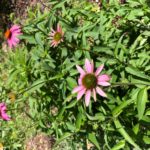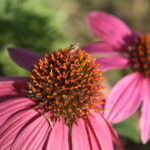FUN FACTS
Botanical name: Echinacea purpurea AKA: 紫锥菊 (zǐ zhuī jú), 松果菊, 紫锥花, Cornflower, Kansas Snakeroot, Purple Cornflower.
CONSTITUENTS
USES/BENEFITS
Boost immune function, relieve pain, reduce inflammation, and have hormonal, antiviral, and antioxidant effects. ¹ Treat urinary tract infections, vaginal yeast infections, ear infections, athlete's foot, sinusitis, and hay fever¹ Many people thinks that echinacea helps with the common cold, but the literature seem controversial. Some trials show that it improves recovery rate while others show no impact.
TYPES
GROWING
PRODUCTS
EDITOR NOTES
TCM NOTES
This information is for education purposes only. Seek the advice of your physician before taking any home remedies, herbs, or supplements.
| Temp | Taste | Ent. Meridians | Photo |
|
Cold
Name
紫锥菊
zǐ zhuī jú
|
|
Lung
Action Clears Heat
|
|
| Indications/Issues | Description / Symptoms | Usefulness(1-10) |
| Cold/Flu | ♦♦♦♦♦♦♦♦ | |
| ♦♦♦♦♦♦♦♦♦♦ | ||
| Actions | Actions | Actions |
DOSAGE information found online
Always consult your doctor before taking any herbal supplements.
PARTS USED
• Flower
***Always consult your doctor before taking any herbal supplements.***
Contraindications
Drugs Interactions
Herb Interactions
Xiang Fan/ Incompatibility:
Xiang Wei/ Counteraction:
Xiang Sha/ Suppression:
Xiang Wu / Antagonism:
Xiang Xu/ Accentuation:
Xiang Shi/ Enhancement:
The roots of this herb is an ingredient in the following formulas:
REFERENCES
This information in this post came from many sources, including class notes, practitioners, websites, webinars, books, magazines, and editor's personal experience. Always consult a doctor prior to using herbal medicine. The information here is strictly for educational purposes.


